An Innovation Manager drives the development and implementation of new ideas and creative solutions within an organization, fostering a culture of continuous improvement and adaptability. A Strategy Manager focuses on long-term planning, analyzing market trends, and aligning business objectives to ensure sustainable growth and competitive advantage. Both roles are essential, with the Innovation Manager emphasizing innovation execution and the Strategy Manager concentrating on overall strategic direction.
Table of Comparison
| Aspect | Innovation Manager | Strategy Manager |
|---|---|---|
| Primary Focus | Driving new ideas and product development | Formulating and executing business strategies |
| Key Responsibilities | Idea generation, innovation pipeline, market trends | Competitive analysis, strategic planning, performance metrics |
| Skillset | Creativity, project management, design thinking | Analytical thinking, business acumen, leadership |
| Goal | Develop breakthrough products and processes | Achieve long-term business growth and sustainability |
| Stakeholder Interaction | R&D teams, product managers, customers | Senior leadership, investors, cross-functional teams |
| Impact | Enhances innovation culture and market differentiation | Aligns organizational goals with market opportunities |
Key Responsibilities of Innovation Managers
Innovation Managers drive the development and implementation of new ideas, products, and processes to maintain competitive advantage and foster growth. They coordinate cross-functional teams, manage innovation pipelines, and evaluate market trends to align innovation projects with organizational goals. Their role includes facilitating collaboration between R&D, marketing, and operations to ensure seamless execution from concept to launch.
Core Duties of Strategy Managers
Strategy Managers primarily develop long-term business plans and identify growth opportunities, ensuring alignment with organizational goals. They conduct market analysis and competitive research to inform decision-making and resource allocation. Their core duties also involve stakeholder communication and facilitating cross-functional collaboration to drive strategic initiatives.
Essential Skills for Success
Innovation Managers excel in creativity, ideation, and driving disruptive change by fostering cross-functional collaboration and leveraging emerging technologies. Strategy Managers prioritize analytical thinking, market research, and long-term planning to align organizational goals with competitive advantages and resource optimization. Both roles require strong leadership, communication skills, and adaptability to navigate complex business environments effectively.
Educational Background and Qualifications
Innovation Managers typically hold degrees in fields such as engineering, design, or business administration with a focus on product development or technology management, emphasizing creativity and technical expertise. Strategy Managers often possess advanced qualifications like an MBA or specialized degrees in strategic management, finance, or economics, highlighting analytical skills and long-term business planning. Both roles demand strong leadership capabilities and proficiency in data analysis tools, but their educational backgrounds reflect their distinct focus on either innovative solution design or corporate strategy formulation.
Impact on Organizational Growth
An Innovation Manager accelerates organizational growth by driving the development and implementation of novel products, services, and processes that foster competitive advantage. A Strategy Manager enhances growth through comprehensive market analysis, long-term planning, and alignment of business objectives with emerging trends. Together, these roles synergize to optimize growth trajectories by blending creative disruption with strategic foresight.
Collaboration and Cross-Functional Influence
Innovation Managers excel in fostering collaboration by driving creative problem-solving across R&D, marketing, and product development teams to generate breakthrough ideas. Strategy Managers leverage cross-functional influence by aligning diverse departments such as finance, operations, and sales around long-term business goals and competitive positioning. Both roles require strong interpersonal skills, but Innovation Managers emphasize collaborative ideation while Strategy Managers focus on integrative execution of strategic plans.
Role in Driving Change
An Innovation Manager drives organizational transformation by fostering creative problem-solving, implementing cutting-edge technologies, and promoting a culture of experimentation. In contrast, a Strategy Manager focuses on long-term business goals by analyzing market trends, developing competitive strategies, and aligning resources to optimize performance. Both roles collaborate to ensure sustainable growth, with the Innovation Manager spearheading change initiatives and the Strategy Manager providing strategic direction.
Performance Metrics and KPIs
Innovation Managers primarily focus on metrics such as the number of new ideas generated, time-to-market for innovative products, and the percentage of revenue from new offerings, reflecting their role in driving creativity and product development. Strategy Managers emphasize KPIs like market share growth, return on investment (ROI), and competitive positioning to evaluate long-term business success and strategic alignment. Both roles use performance metrics tailored to their objectives, with Innovation Managers tracking innovation effectiveness and Strategy Managers measuring overall strategic execution and business impact.
Career Pathways and Advancement
Innovation Managers typically advance by developing expertise in emerging technologies and driving product or process improvements, often transitioning into roles like Chief Innovation Officer or Head of R&D. Strategy Managers progress by honing skills in market analysis, competitive intelligence, and business planning, frequently moving into positions such as Director of Strategy or Chief Strategy Officer. Both career pathways require strong leadership and cross-functional collaboration but differ in focus, with Innovation Managers emphasizing creativity and implementation, while Strategy Managers concentrate on long-term planning and organizational positioning.
Industry Trends Shaping Both Roles
Innovation Managers drive the adoption of disruptive technologies and foster creative problem-solving to keep companies ahead in rapidly evolving markets like AI and IoT. Strategy Managers focus on integrating long-term market analysis and competitive intelligence, ensuring alignment with global trends such as sustainability and digital transformation. Both roles increasingly rely on data analytics and agile methodologies to respond proactively to industry shifts and maintain organizational competitiveness.
Innovation Manager vs Strategy Manager Infographic

 jobdiv.com
jobdiv.com